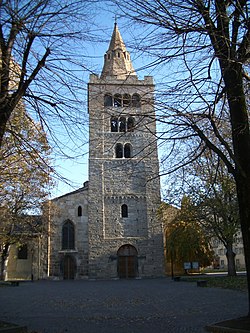Roman Catholic Diocese of Sion
|
Diocese of Sion Dioecesis Sedunensis Bistum Sitten (de) Évêché de Sion (fr) |
|
|---|---|

|
|
| Location | |
| Country | Switzerland |
| Metropolitan | Immediately Subject to the Holy See |
| Statistics | |
| Area | 5,589 km2 (2,158 sq mi) |
| Population - Total - Catholics |
(as of 2010) 309,202 235,735 (76.2%) |
| Parishes | 158 |
| Information | |
| Denomination | Roman Catholic |
| Rite | Latin |
| Established | 4th century |
| Cathedral | Cathédrale Notre-Dame du Glarier |
| Current leadership | |
| Pope | Francis |
| Bishop | Jean-Marie Lovey |
| Emeritus Bishops |
Norbert Brunner Cardinal Henri Schwery |
| Map | |
 Map of the modern diocese of Sion within Switzerland |
|
| Website | |
| Website of the Diocese | |
| Prince-Bishopric of Sion or Prince-Bishopric of Wallis |
||||||||||||
|
Fürstbistum Sitten (de) Prince-Évêché de Sion (fr) Dioecesis Sedunensis (la) |
||||||||||||
| State of the Holy Roman Empire | ||||||||||||
|
||||||||||||
|
||||||||||||
|
Anthem Notre Valais (, ) |
||||||||||||
|
Map of Switzerland in 1378, showing the Bishopric labelled Valais
|
||||||||||||
| Capital | Sion | |||||||||||
| Languages | French, Walser German | |||||||||||
| Religion | Roman Catholic | |||||||||||
| Government | ||||||||||||
| Bishop | ||||||||||||
| • | before 381–391 | St Theodore of Octodurus | ||||||||||
| Prince-Bishop | ||||||||||||
| • | 998–1017 | Hugo, Count of Valais (first Prince-Bishop) |
||||||||||
| • | 1613–38 | Hildebrand II Jost (last de facto Prince-Bishop) |
||||||||||
| • | 1790–1807 | Joseph-Antoine Blatter (last de jure Prince-Bishop) |
||||||||||
| Historical era | Middle Ages | |||||||||||
| • | Bishopric founded | before 381 999 | ||||||||||
| • | See moved to Sion | 589 | ||||||||||
| • | Bequeathed county of Valais |
around 999 |
||||||||||
| • | Became associate of Old Swiss Confed. |
March 12, 1529 |
||||||||||
| • | Became republic under guidance of the Bishop |
1628 |
||||||||||
| • |
Foundation of Helvetic Republic |
April 12, 1798 1798 |
||||||||||
| • | Entered Swiss Confed. as canton of Valais |
August 4, 1815 |
||||||||||
|
||||||||||||
The Diocese of Sion (Latin: Dioecesis Sedunensis, French: Évêché de Sion, German: Bistum Sitten) is a Roman Catholic ecclesiastical territory in the canton of Valais, Switzerland. It is the oldest bishopric in the country and one of the oldest north of the Alps. The history of the Bishops of Sion, of the Abbey of St. Maurice of Valais as a whole are inextricably intertwined.
The see was established at Octodurum, now called Martigny, the capital of the Roman province of Alpes Poeninae. The first authentically historical bishop was Saint Theodore/Theodolus (died in 391), who was present at the Council of Aquileia in 381. He founded the Abbey of Saint-Maurice, with a small church in honor of Saint Maurice, martyred there c. 300, when he united the local hermits in a common life, thus beginning the Abbey of Saint-Maurice, the oldest north of the Alps. Theodore rebuilt the church at Sion, which had been destroyed by Emperor Maximinus at the beginning of the 4th century. At first the new diocese was a suffragan of the archdiocese of Vienne; later it became suffragan of Tarentaise.
In 589 the bishop, St. Heliodorus, transferred the see to Sion, leaving the low-lying, flood-prone site of Octodurum, where the Drance joins the Rhone. Though frequently the early bishops were also abbots of Saint-Maurice, the monastic community was jealously watchful that the bishops should not extend their jurisdiction over the abbey. Several of the bishops united both offices: Wilcharius (764-780), previously Archbishop of Vienne, whence he had been driven by the Moors; St. Alteus, who received from the pope a bull of exemption in favor of the monastery (780); Aimo II, son of Count Humbert I of Savoy, who entertained Leo IX at Saint-Maurice in 1049.
...
Wikipedia



